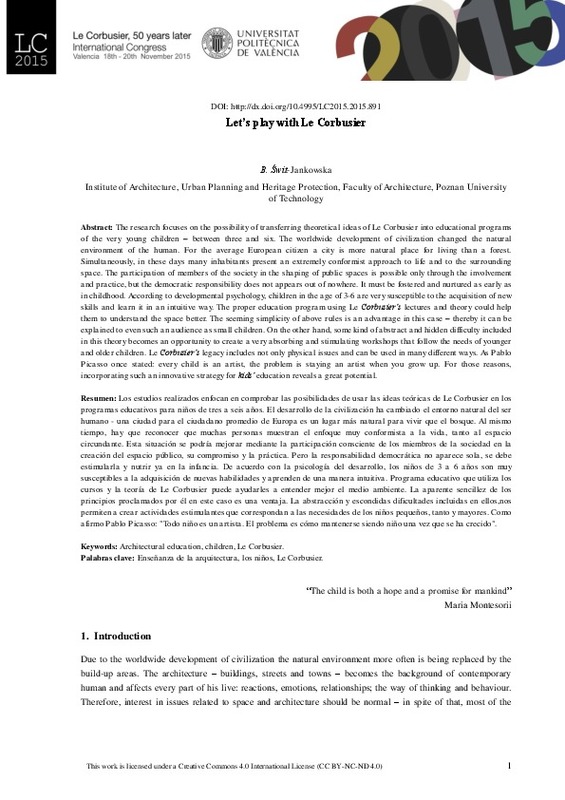JavaScript is disabled for your browser. Some features of this site may not work without it.
Buscar en RiuNet
Listar
Mi cuenta
Estadísticas
Ayuda RiuNet
Admin. UPV
Let’s play with Le Corbusier
Mostrar el registro sencillo del ítem
Ficheros en el ítem
| dc.contributor.author | Świt-Jankowska, Barbara
|
es_ES |
| dc.date.accessioned | 2017-09-13T07:08:37Z | |
| dc.date.available | 2017-09-13T07:08:37Z | |
| dc.date.issued | 2016-03-03 | |
| dc.identifier.isbn | 9788490483732 | |
| dc.identifier.uri | http://hdl.handle.net/10251/87151 | |
| dc.description.abstract | [EN] The research focuses on the possibility of transferring theoretical ideas of Le Corbusier into educational programs of the very young children – between three and six. The worldwide development of civilization changed the natural environment of the human. For the average European citizen a city is more natural place for living than a forest. Simultaneously, in these days many inhabitants present an extremely conformist approach to life and to the surrounding space. The participation of members of the society in the shaping of public spaces is possible only through the involvement and practice, but the democratic responsibility does not appears out of nowhere. It must be fostered and nurtured as early as in childhood. According to developmental psychology, children in the age of 3-6 are very susceptible to the acquisition of new skills and learn it in an intuitive way. The proper education program using Le Corbusier’s lectures and theory could help them to understand the space better. The seeming simplicity of above rules is an advantage in this case – thereby it can be explained to even such an audience as small children. On the other hand, some kind of abstract and hidden difficulty included in this theory becomes an opportunity to create a very absorbing and stimulating workshops that follow the needs of younger and older children. Le Corbusier’s legacy includes not only physical issues and can be used in many different ways. As Pablo Picasso once stated: every child is an artist, the problem is staying an artist when you grow up. For those reasons, incorporating such an innovative strategy for kids’ education reveals a great potential. | es_ES |
| dc.description.abstract | [ES] Los estudios realizados enfocan en comprobar las posibilidades de usar las ideas teóricas de Le Corbusier en los programas educativos para niños de tres a seis años. El desarrollo de la civilización ha cambiado el entorno natural del ser humano - una ciudad para el ciudadano promedio de Europa es un lugar más natural para vivir que el bosque. Al mismo tiempo, hay que reconocer que muchas personas muestran el enfoque muy conformista a la vida, tanto al espacio circundante. Esta situación se podría mejorar mediante la participación consciente de los miembros de la sociedad en la creación del espacio público, su compromiso y la práctica. Pero la responsabilidad democrática no aparece sola, se debe estimularla y nutrir ya en la infancia. De acuerdo con la psicología del desarrollo, los niños de 3 a 6 años son muy susceptibles a la adquisición de nuevas habilidades y aprenden de una manera intuitiva. Programa educativo que utiliza los cursos y la teoría de Le Corbusier puede ayudarles a entender mejor el medio ambiente. La aparente sencillez de los principios proclamados por él en este caso es una ventaja. La abstracción y escondidas dificultades incluidas en ellos,nos permiten a crear actividades estimulantes que correspondan a las necesidades de los niños pequeños, tanto y mayores. Como afirmo Pablo Picasso: "Todo niño es un artista. El problema es cómo mantenerse siendo niño una vez que se ha crecido" | es_ES |
| dc.format.extent | 9 | es_ES |
| dc.language | Inglés | es_ES |
| dc.publisher | Editorial Universitat Politècnica de València | es_ES |
| dc.relation.ispartof | LE CORBUSIER. 50 AÑOS DESPUÉS | es_ES |
| dc.rights | Reconocimiento - No comercial - Sin obra derivada (by-nc-nd) | es_ES |
| dc.subject | architecture | es_ES |
| dc.subject | le corbusier | es_ES |
| dc.subject | modern movement | es_ES |
| dc.title | Let’s play with Le Corbusier | es_ES |
| dc.type | Capítulo de libro | es_ES |
| dc.type | Comunicación en congreso | es_ES |
| dc.identifier.doi | 10.4995/LC2015.2015.891 | |
| dc.rights.accessRights | Abierto | es_ES |
| dc.description.bibliographicCitation | Świt-Jankowska, B. (2016). Let’s play with Le Corbusier. En LE CORBUSIER. 50 AÑOS DESPUÉS. Editorial Universitat Politècnica de València. 2175-2184. https://doi.org/10.4995/LC2015.2015.891 | es_ES |
| dc.description.accrualMethod | OCS | es_ES |
| dc.relation.conferencename | LC2015 - Le Corbusier, 50 years later | es_ES |
| dc.relation.conferencedate | November 18-20,2015 | es_ES |
| dc.relation.conferenceplace | Valencia, Spain | es_ES |
| dc.relation.publisherversion | http://ocs.editorial.upv.es/index.php/LC2015/LC2015/paper/view/891 | es_ES |
| dc.description.upvformatpinicio | 2175 | es_ES |
| dc.description.upvformatpfin | 2184 | es_ES |
| dc.type.version | info:eu-repo/semantics/publishedVersion | es_ES |
| dc.relation.pasarela | OCS\891 | es_ES |








